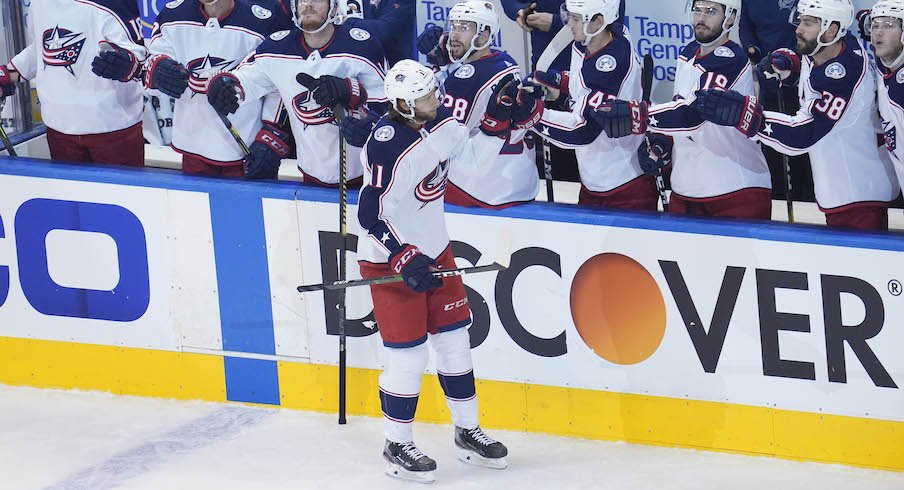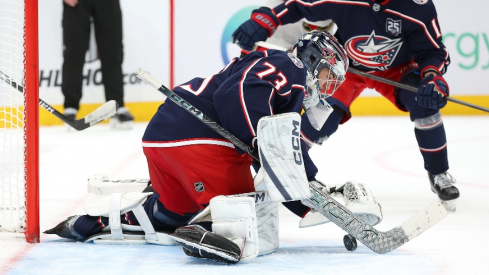The t-shirts said it all.
No further explanation needed.
The same message on the chest of every Columbus Blue Jackets player as they disembarked buses on July 27 aptly described what they were getting themselves into. Each of them had accepted sacrificing the normalcy of their daily lives amid a pandemic in order for the NHL to make its grand return over four months after pausing indefinitely in mid-March due to coronavirus concerns. They left their spouses and children to embark upon a journey that would last only a couple of weeks if they got eliminated immediately but could have them playing hockey into early October.
Traveling to Toronto – the Eastern Conference hub city – was a choice, albeit a relatively easy one for most on the team despite what they’d have to give up. All Blue Jackets players made the trip to Canada.
“I'm excited about getting there, just to get into it and starting to experience what it's going to be like,” coach John Tortorella said in the days leading up to the bubble entrance.
As it turns out, Columbus spent less than a month in the bubble, leaving after falling, 4-1, in a first-round Stanley Cup playoff series to the Tampa Bay Lightning. They headed home on Thursday, one day after blowing a two-goal lead and dropping the elimination game in overtime.
From a safety perspective, the bubble – an experiment enacted by the NHL, NBA and MLS to play games without spreading the virus – was an indisputable success. Not a single player or employee of the Blue Jackets in Toronto contracted COVID-19. How do we know this? Because in the month that has passed since teams began entering Toronto and Western Conference hub city Edmonton, nobody in the bubble has yet tested positive for coronavirus, per the NHL.
“I think the league's done a great job with the whole operation,” general manager Jarmo Kekalainen said on Friday. “It's incredible how much success we've had with everybody's stayed healthy and safe in that environment.”
Tortorella added: “I think the league did just a fantastic job of putting this together.”
A lot of work, naturally, went into putting together such an impromptu plan of splitting the league’s teams between hub cities. And it seems to have paid off – though everybody from the NHL will keep their fingers crossed it continues going as planned.
To Tortorella, playing in the bubble “wasn’t a challenge.”
“We're pros. Players are pros,” Tortorella said. “We just prepared each and every day. It was a wild ride, as far as some of the ebbs and flows in our Toronto series and even in the Tampa series, where I think we played our two best games the last two games and still don't find a way to win. That's the game of hockey that you have to handle. The bubble brings in a whole different dynamic, but it didn't affect our preparation, didn't affect how we try to go about our business. I give the league a lot of credit.
“It was a workmanlike attitude that we had, and we certainly were allowed to do that in the way things were set up.”
On the second day in the bubble, Tortorella stressed the importance of getting into a routine, and he managed to do just that. And so did Kekalainen.
The general manager rarely altered what he would do on a daily basis.
He’d go to the noon game, go to the 4 p.m. game, then go to the 8 p.m. game. By 11 p.m., he’d be back in his hotel, readying himself to go to bed, wake up and do it all again the next day.
“It was hockey 24/7,” Kekalainen said. “Other times than that, we were talking about our team. It's a unique opportunity, obviously, to watch those games live. You'd have to take two months to see them on a regular schedule in a normal situation to travel around and watch those teams so many times. Now you can just watch 10 minutes from your hotel room into the suite at the rink and watch the games. It was awesome, and we used it very well, hopefully to our advantage.”
Away from the games at Scotiabank Arena, he says it felt like a typical road game.
“You weren't able to go to your favorite restaurant, but you could order food from them and eat it at the lounge in the hotel,” Kekalainen said. “There was the opportunity to watch hockey, which was great. The facilities, the gyms and the tennis courts and all that at the Hotel X were unbelievable, and BMO Field was a great place to throw a frisbee around or a football or soccer. There's lots of things to do.”
The main issue, Kekalainen said, was that he was unable to get out of the hotel and walk around the city the same way he would when Columbus plays normal road games. Instead, most of the sunshine he enjoyed came at the one patio at his hotel or when he’d take a shuttle to BMO Field, which is where Toronto FC of the MLS plays.
“Didn't particularly like being surrounded by iron fences and not be able to step outside and walk,” Kekalainen said. “But that was the price to be paid to be safe.”

